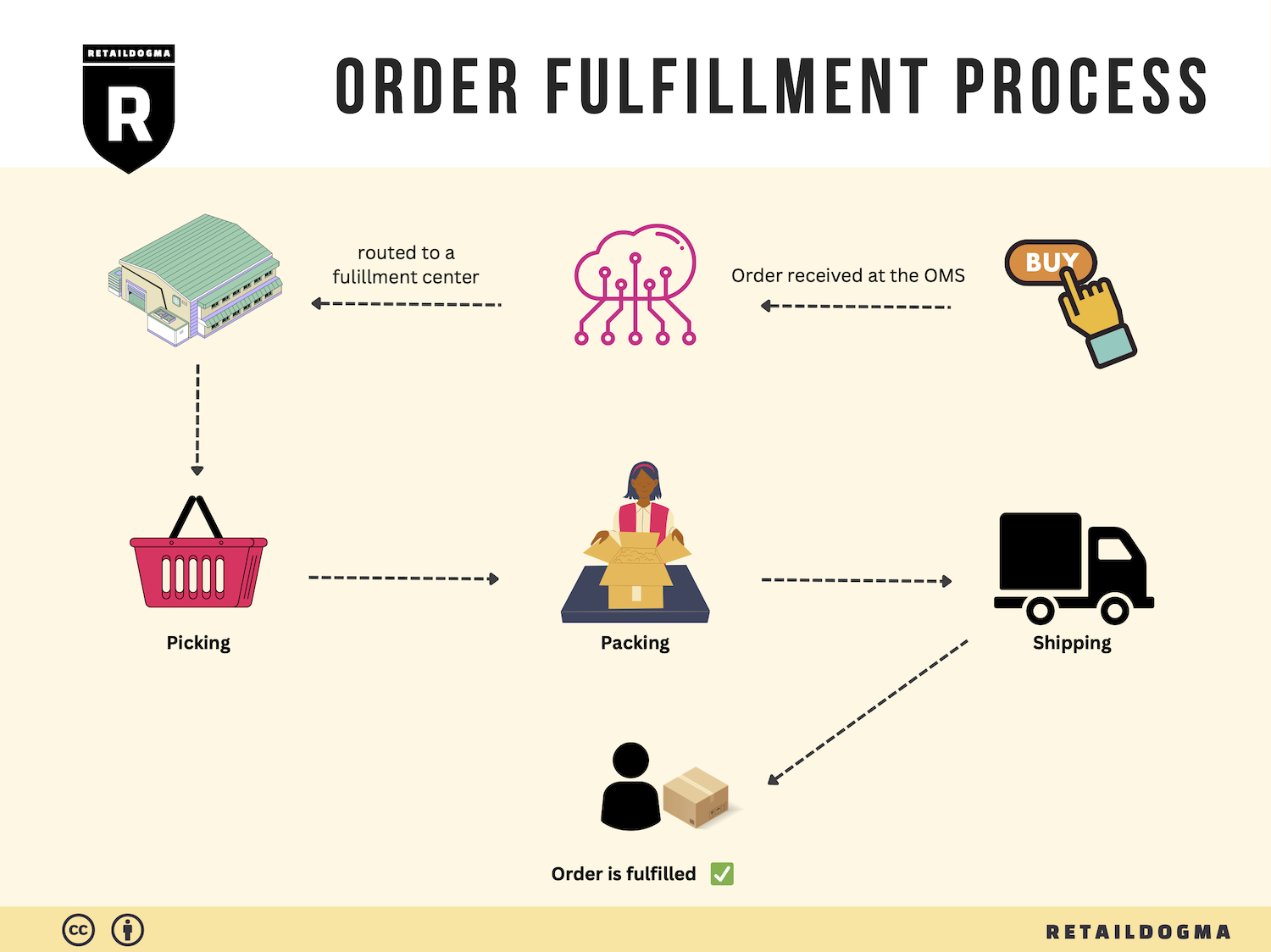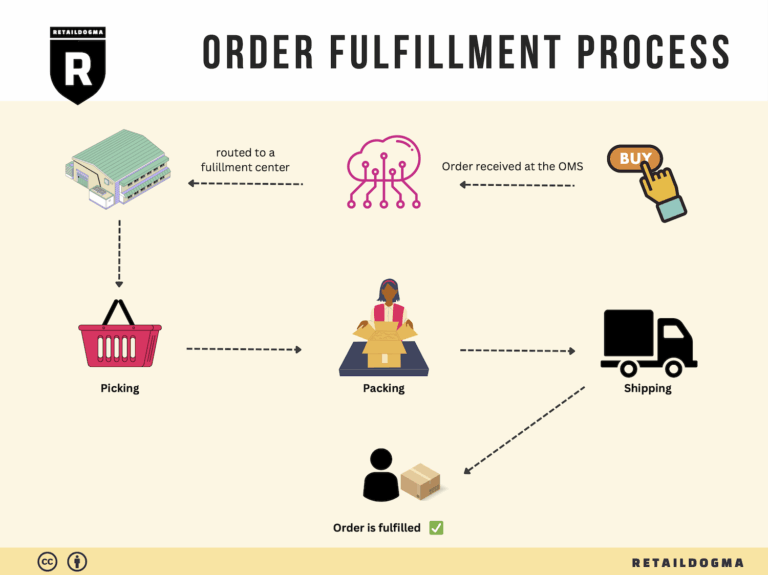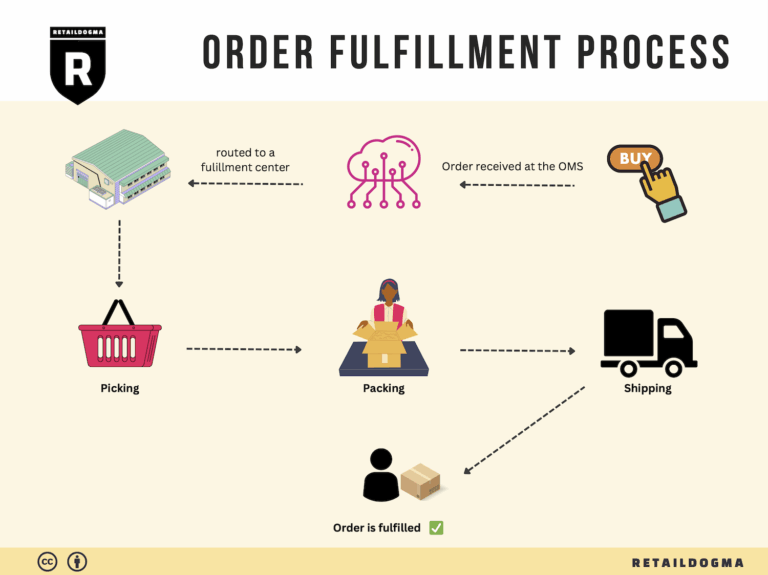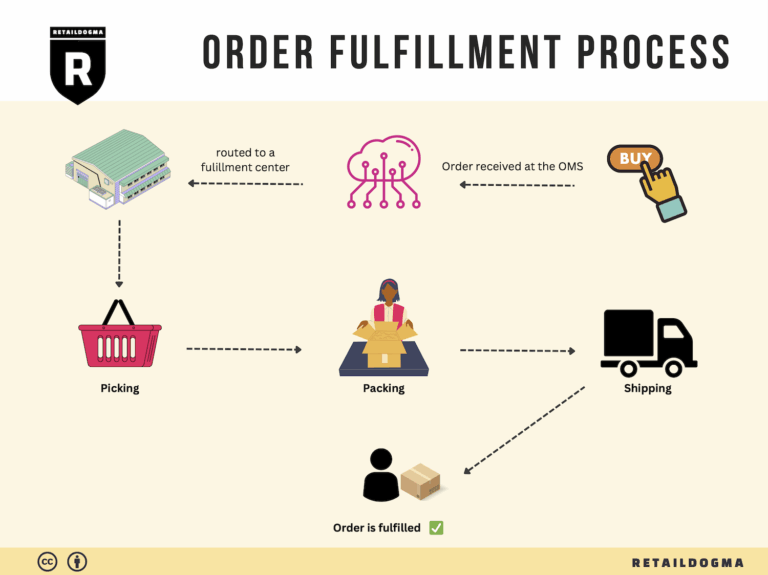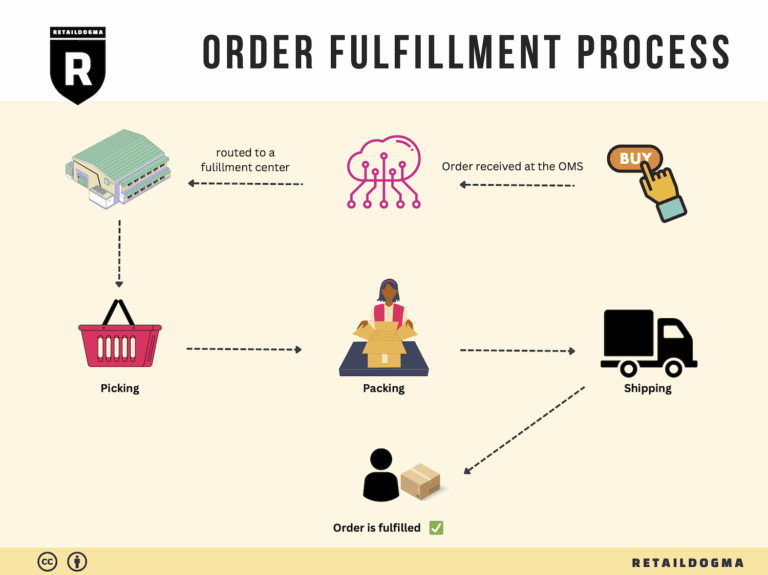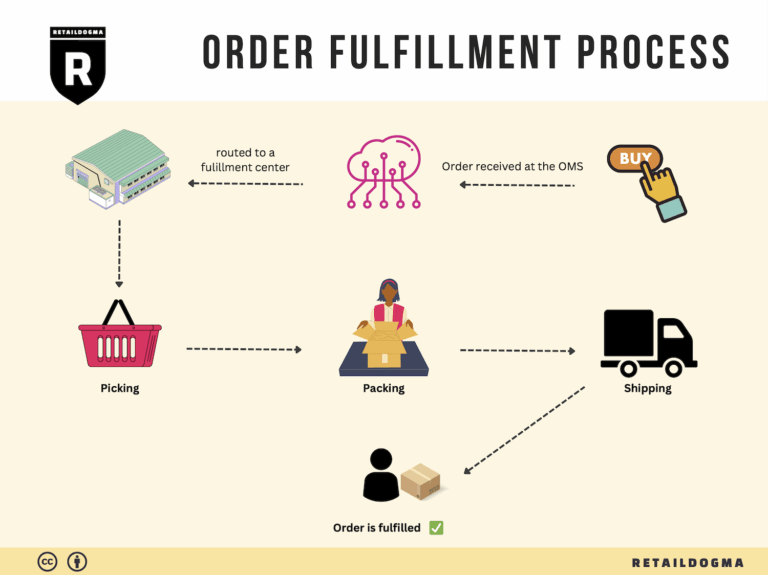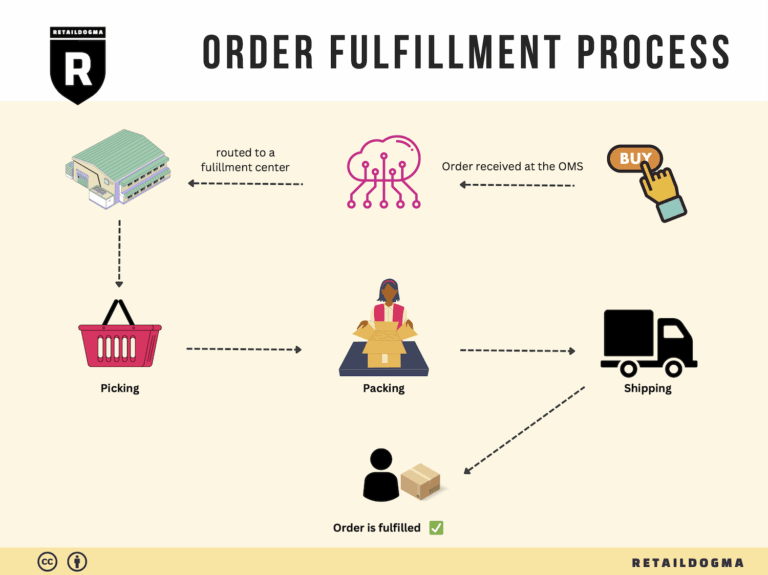What Is A Fulfillment Center? A Complete Guide (2025)
What is E-commerce Fulfillment? An Introduction for Growing Businesses
Understanding E-commerce Fulfillment: Navigating the Logistics Maze
As your e-commerce business grows, the excitement of increasing sales can quickly turn into the stress of managing logistics. One of the most common pain points for online retailers is the overwhelming task of packing and shipping orders. The process of getting a product from your warehouse to a customer’s doorstep can seem daunting, especially as order volumes rise. This is where e-commerce fulfillment comes into play, simplifying the journey from order to delivery.
E-commerce fulfillment is fundamentally the process of receiving, processing, and delivering orders to customers. It encompasses everything from inventory management to packing and shipping. As a growing business, understanding the nuances of fulfillment can significantly enhance your operational efficiency and customer satisfaction.
In this guide, we will cover essential aspects of e-commerce fulfillment that every business owner should know:
-
Fulfillment Models: We’ll explore various fulfillment options, including Third-Party Logistics (3PL) and Fulfillment by Amazon (FBA). Each model has its pros and cons, and selecting the right one can impact your scalability and customer experience.
-
Core Services: Understanding the core services offered by fulfillment centers is crucial. These services often include inventory storage, order processing, packing, shipping, and returns management. We’ll break down what to expect from a fulfillment partner and how these services align with your business needs.
-
Choosing the Right Partner: Selecting a fulfillment partner is a significant decision that can affect your bottom line. We will discuss key factors to consider when evaluating potential partners, including technology integration, geographic location, and customer service.
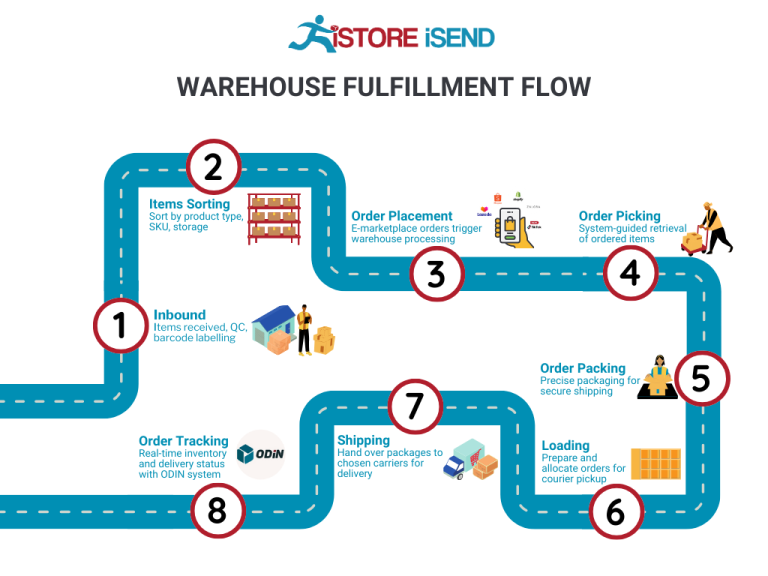
-
Pricing Structures: The cost of fulfillment can vary widely based on the services provided, volume of orders, and specific requirements of your business. We will provide insights into common pricing models, helping you budget and forecast accurately.
The goal of this guide is to empower your business to make informed decisions about logistics and fulfillment. By understanding the various components of e-commerce fulfillment, you can streamline operations, enhance customer satisfaction, and ultimately drive growth. Whether you are just starting out or looking to optimize an existing operation, this guide will serve as a practical resource to navigate the complexities of e-commerce fulfillment.
What You’ll Learn In This Guide
- What is E-commerce Fulfillment? An Introduction for Growing Businesses
- The Order Fulfillment Process: From ‘Buy’ Button to Customer’s Door
- Comparing Fulfillment Models: In-House vs. 3PL vs. Dropshipping
- A Deep Dive into Amazon FBA: Pros, Cons, and Who It’s For
- Core Services Offered by Fulfillment Centers
- How to Choose a Fulfillment Partner: A 6-Point Checklist
- Understanding Fulfillment Pricing: A Breakdown of Common Fees
- Frequently Asked Questions (FAQs) about Fulfillment
- Conclusion: Is Outsourcing Fulfillment the Right Move for Your Business?
- Important Disclaimer
The Order Fulfillment Process: From ‘Buy’ Button to Customer’s Door
1. Receiving Inventory
The first step in the order fulfillment process is receiving inventory. This involves the arrival of products at the fulfillment center, where they are unloaded, inspected, and documented. Each item is checked against purchase orders to ensure accuracy and quality. This is crucial because any discrepancies can lead to stockouts or delays in fulfilling customer orders.
During this step, key terms such as SKU (Stock Keeping Unit) come into play. An SKU is a unique identifier for each product, allowing for efficient tracking and management of inventory. Properly receiving inventory not only ensures that the products meet quality standards but also sets the stage for effective inventory management. Accurate receiving processes help in maintaining optimal stock levels, which is essential for meeting customer demand and minimizing holding costs.
2. Warehouse Storage
Once inventory is received, it is moved to the storage area of the fulfillment center. The organization of this space is critical to streamline future steps in the fulfillment process. Products are typically stored in designated locations based on their SKUs, which aids in efficient retrieval later on. This step involves categorizing items, shelving them appropriately, and updating the inventory management system to reflect their locations.
Effective warehouse storage is important because it directly impacts order fulfillment speed and accuracy. A well-organized warehouse reduces the time spent searching for products, which is vital in a competitive e-commerce landscape. Key terms relevant here include bin location and inventory management system, both of which facilitate the tracking of stock levels and locations.
3. Order Picking
Order picking is the process of retrieving items from storage in response to customer orders. Once an order is placed, a pick list is generated, detailing the items and their respective locations within the warehouse. Warehouse staff then use this list to gather the products for packing.
This step is significant as it directly influences the accuracy and efficiency of order fulfillment. Errors in picking can lead to incorrect shipments, resulting in customer dissatisfaction and increased return rates. The use of technologies such as RFID (Radio Frequency Identification) and pick-to-light systems can enhance this process, allowing for real-time tracking and minimizing the chances of human error. Efficient order picking is essential for timely delivery and customer satisfaction.
4. Order Packing
After the items are picked, they move to the packing station, where they are prepared for shipment. This involves checking the items against the order details to ensure accuracy, as well as packing them securely to prevent damage during transit. Packaging materials such as boxes, padding, and tape are utilized based on the nature of the products being shipped.

Packing is a critical step because it not only protects the products but also reflects the brand’s commitment to quality. Properly packed orders reduce the likelihood of returns due to damage and can enhance customer satisfaction. Key terms in this step include packing slip and dimensional weight, which are essential for ensuring that orders are documented correctly and that shipping costs are calculated based on package size and weight.
5. Shipping & Delivery
The final step in the order fulfillment process is shipping and delivery. Once the orders are packed, they are labeled and handed over to shipping carriers for delivery to the customer. This stage involves selecting the best shipping method based on factors such as cost, speed, and destination.
This step is vital as it directly impacts the customer’s experience. Timely and accurate delivery can lead to repeat business and positive reviews, while delays or issues can harm the brand’s reputation. Important concepts here include last-mile delivery and tracking systems, which allow both the business and the customer to monitor the shipment’s progress. Efficient shipping and delivery processes are essential for maintaining a competitive edge in the e-commerce market.
In summary, understanding each step of the order fulfillment process is crucial for e-commerce businesses looking to scale their operations. By optimizing inventory receiving, storage, order picking, packing, and shipping, companies can enhance efficiency, reduce costs, and ultimately improve customer satisfaction.
Comparing Fulfillment Models: In-House vs. 3PL vs. Dropshipping
Fulfillment Models Overview
When it comes to scaling an e-commerce business, understanding the various fulfillment models is critical. Each model has its unique characteristics, advantages, and challenges. Below is a comparison of the three primary fulfillment models: In-House Fulfillment, Third-Party Logistics (3PL), and Dropshipping.
| Model | Who Handles Inventory | Best For (Business Stage) | Key Advantage | Key Disadvantage |
|---|---|---|---|---|
| In-House Fulfillment | The business itself | Established businesses | Full control over operations and branding | High overhead costs and resource-intensive |
| Third-Party Logistics (3PL) | Third-party providers | Growing businesses | Scalability and reduced operational burden | Less control over inventory and shipping |
| Dropshipping | Supplier/vendor | Startups and small businesses | Low upfront investment and risk | Lower profit margins and reliance on suppliers |
In-House Fulfillment
In-house fulfillment is the process where a business manages all aspects of warehousing, inventory, and shipping directly. This model is typically favored by established businesses with a stable customer base and a robust product line. The primary advantage of in-house fulfillment is the complete control it offers over the entire supply chain, from inventory management to shipping processes. This control allows businesses to implement specific branding strategies, customize packaging, and ensure quality standards are met.
However, this model comes with significant disadvantages. The costs associated with maintaining a warehouse, hiring staff, and managing logistics can be substantial. Additionally, businesses may find themselves overwhelmed by the operational demands as they scale, which can divert focus from core business activities such as marketing and customer engagement. For companies like Excelligence, which has invested in a state-of-the-art fulfillment center, the in-house model can provide a strategic advantage, allowing for efficient operations tailored to their unique needs.
Third-Party Logistics (3PL)
Third-party logistics (3PL) refers to outsourcing logistics operations to specialized service providers. This model is ideal for growing businesses that require flexibility and scalability. 3PL providers handle warehousing, inventory management, and shipping, allowing businesses to focus on core activities like sales and customer service. The key advantage of using a 3PL is the ability to scale operations quickly without the burden of managing logistics in-house. As businesses grow, 3PLs can easily accommodate increased order volumes and expand service offerings.
On the downside, relying on a 3PL means businesses have less control over their inventory and shipping processes. Any issues with the 3PL provider, such as delays or inaccuracies, can directly affect customer satisfaction. Additionally, there may be hidden costs associated with using a 3PL, such as storage fees or surcharges for expedited shipping. For companies like Excelligence, leveraging a 3PL can provide the flexibility needed to handle seasonal spikes in demand while ensuring that core competencies remain focused on educational products and customer engagement.
Dropshipping
Dropshipping is a fulfillment model where retailers sell products without holding inventory. Instead, when a retailer sells a product, they purchase the item from a third-party supplier who then ships it directly to the customer. This model is particularly appealing for startups and small businesses looking to minimize risk and upfront investment. The primary advantage of dropshipping is that it requires very little capital to get started since there is no need to purchase inventory upfront. This allows entrepreneurs to test new products and markets without significant financial commitment.
However, dropshipping also comes with its challenges. Profit margins are typically lower compared to other fulfillment models, as suppliers often take a significant cut. Additionally, the retailer’s reliance on the supplier for inventory and shipping means that any issues—such as stock shortages or shipping delays—can reflect poorly on the retailer. For businesses like Excelligence, while dropshipping can be a viable option for certain product lines, it may not align well with their focus on high-quality educational products that require a consistent level of service and customer experience.
Conclusion
Selecting the right fulfillment model is crucial for e-commerce businesses looking to scale effectively. Each model—In-House Fulfillment, 3PL, and Dropshipping—offers distinct advantages and disadvantages that should be weighed against the company’s current stage, resources, and strategic goals. For companies like Excelligence, understanding these models can help optimize their operations, enhance customer satisfaction, and ultimately drive growth in a competitive market. As businesses evolve, they may find that a hybrid approach combining elements from multiple fulfillment models can best meet their needs.
A Deep Dive into Amazon FBA: Pros, Cons, and Who It’s For
Understanding Fulfillment by Amazon (FBA)
Fulfillment by Amazon (FBA) is a service provided by Amazon that allows e-commerce sellers to store their products in Amazon’s fulfillment centers. Amazon takes care of storage, packaging, and shipping of products directly to customers. Sellers benefit from the extensive logistics network that Amazon has developed, enabling them to reach millions of customers worldwide.
How FBA Works
-
Setting Up Your Account: To get started, sellers must create an Amazon seller account and enroll in the FBA program. This includes agreeing to Amazon’s terms and conditions.
-
Listing Products: Once enrolled, sellers can list their products on Amazon’s marketplace. They can either create new listings or convert existing listings to FBA.
-
Shipping Inventory: Sellers send their inventory to Amazon’s fulfillment centers. Amazon provides guidelines on how to prepare and package the products to ensure they meet their standards.
-
Storage and Fulfillment: Once the products are received at the fulfillment center, they are stored until an order is placed. When a customer orders a product, Amazon picks, packs, and ships the item on behalf of the seller.
-
Customer Service: Amazon also handles all customer service and returns for FBA products, allowing sellers to focus on other aspects of their business.
-
Payment: After a sale, Amazon deducts fees for the FBA service from the seller’s account and transfers the remaining amount to the seller.
Pros of Fulfillment by Amazon (FBA)
-
Prime Eligibility: Products fulfilled by Amazon are eligible for Amazon Prime. This increases visibility and can lead to higher sales since Prime members often prefer products that offer fast and free shipping.
-
Customer Trust: Selling through FBA builds customer trust as consumers are familiar with Amazon’s brand and reliability. This can lead to increased conversion rates compared to non-FBA listings.
-
Multi-Channel Fulfillment: FBA allows sellers to fulfill orders from other sales channels, such as their own websites or eBay, using Amazon’s logistics infrastructure. This streamlines operations and reduces the complexity of managing multiple fulfillment processes.
-
Scalability: FBA allows sellers to scale their business without needing to invest heavily in their own warehousing and shipping infrastructure. This is especially beneficial for small to medium-sized businesses looking to grow.
-
Time Efficiency: With Amazon handling storage, packing, shipping, and customer service, sellers can save time and focus on other critical aspects of their business, such as marketing and product development.
-
Global Reach: FBA provides access to Amazon’s international marketplaces, allowing sellers to reach customers in various countries without needing to navigate the complexities of international shipping themselves.
Cons of Fulfillment by Amazon (FBA)
-
High Fees: While FBA offers many benefits, the associated costs can be high. Sellers must pay storage fees, fulfillment fees, and additional charges for long-term storage. These fees can eat into profit margins, particularly for low-cost or low-margin products.
-
Strict Inventory Rules: Amazon has strict guidelines regarding inventory management, including how much stock can be sent to their fulfillment centers. Failure to adhere to these rules can result in penalties or increased costs.
-
Commingling Risks: When using FBA, products from different sellers may be stored together (commingled inventory). This can lead to issues where sellers are held accountable for returns or problems with products that they did not send.
-
Lack of Control: Once products are with Amazon, sellers have limited control over how their products are handled, packaged, and shipped. This can affect branding and customer experience.
-
Return Policy: Amazon’s return policy is customer-friendly, but it can be costly for sellers. Returned products may not be restocked, and sellers may incur additional fees.
-
Dependency on Amazon: Relying heavily on Amazon for sales can be risky. Changes in Amazon’s policies, algorithms, or marketplace dynamics can significantly impact a seller’s business.
Who is FBA Best For?
Fulfillment by Amazon is best suited for:
-
Small to Medium-Sized Businesses: Companies that lack the resources to manage their own logistics and fulfillment can benefit significantly from FBA’s infrastructure.
-
E-commerce Entrepreneurs: New sellers looking to enter the market quickly and with minimal upfront investment in logistics.
-
Brands Seeking Rapid Growth: Businesses looking to scale quickly can leverage Amazon’s vast customer base and logistics capabilities.
-
Sellers with Popular Products: Those with products that have a high turnover rate can benefit from the speed and efficiency of FBA.
-
Multi-Channel Sellers: Businesses that sell on multiple platforms but want to simplify their fulfillment process can utilize FBA for order fulfillment across various channels.
In conclusion, while Fulfillment by Amazon offers numerous advantages that can help scale an e-commerce business, it is essential for sellers to weigh these against the potential downsides. Understanding both the benefits and challenges can empower businesses to make informed decisions about their fulfillment strategies.
Core Services Offered by Fulfillment Centers
Inventory Management & Warehousing
Inventory management and warehousing are foundational services provided by fulfillment centers, crucial for any e-commerce business aiming to scale effectively. This service involves the systematic storage and tracking of products to ensure availability when needed while minimizing excess inventory and associated costs.
A robust inventory management system allows businesses to maintain optimal stock levels, reducing the risk of stockouts that can lead to lost sales. Fulfillment centers utilize advanced technology, such as real-time inventory tracking systems, to monitor stock levels and automate reorder processes. This ensures that products are consistently available, meeting customer demands without overstocking, which can tie up cash flow and increase holding costs.
Moreover, strategic warehousing solutions, often located near major transportation hubs, facilitate faster shipping times. For e-commerce businesses, this means quicker delivery to customers, enhancing satisfaction and loyalty. A well-organized warehouse layout further streamlines operations, making it easier to locate and retrieve products efficiently, thus improving overall order fulfillment speed.
Pick and Pack Services
Pick and pack services are essential for e-commerce businesses that require flexibility and efficiency in order fulfillment. This process involves selecting items from the warehouse (picking) and preparing them for shipment (packing) based on customer orders.
Fulfillment centers typically employ sophisticated picking technologies, such as barcode scanning and automated picking systems, to enhance accuracy and reduce picking errors. By outsourcing this service, businesses can benefit from improved order accuracy and reduced labor costs. A fulfillment center’s expertise in pick and pack operations often leads to faster order processing times, allowing businesses to meet or exceed customer expectations for delivery speed.
Additionally, the packing process can be tailored to meet specific brand requirements, such as custom packaging or including promotional materials, which can enhance the customer experience. This personalized touch not only fosters brand loyalty but also encourages repeat purchases, ultimately driving sales growth.
Kitting and Assembly
Kitting and assembly are specialized services offered by fulfillment centers that can significantly streamline operations for e-commerce businesses. Kitting involves bundling multiple products together into a single package, while assembly refers to the process of putting together components to create a final product.
For businesses that sell educational materials or toys, for instance, kitting can allow them to offer product bundles that appeal to customers seeking comprehensive solutions. This not only simplifies the purchasing process for consumers but can also increase average order value as customers are encouraged to buy bundled products at a perceived discount.
In terms of assembly, fulfillment centers can handle complex product configurations that require additional labor and expertise. This is particularly beneficial for businesses that do not have the space or resources to manage assembly in-house. By outsourcing these tasks, businesses can focus on core operations such as marketing and customer service, while ensuring that products are ready for shipment without delay.
Returns Management (Reverse Logistics)
Returns management, or reverse logistics, is an often-overlooked yet critical service provided by fulfillment centers. Efficient handling of returns is essential in the e-commerce industry, where customers expect hassle-free return processes. A fulfillment center can streamline this process, ensuring that returned items are processed quickly and efficiently.
A well-structured returns management system allows businesses to handle returns in a way that minimizes disruption to operations. Fulfillment centers can inspect returned items, restock them if they are in sellable condition, or process them for refurbishment or recycling as needed. This not only helps recover value from returned goods but also maintains accurate inventory levels.
Additionally, an effective returns process enhances customer satisfaction. When customers know they can return products easily, they are more likely to make purchases, knowing that they have the option to return items that do not meet their expectations. This can lead to increased sales and improved customer loyalty, as a positive return experience encourages repeat business.
In conclusion, leveraging the core services offered by fulfillment centers—inventory management and warehousing, pick and pack services, kitting and assembly, and returns management—can significantly enhance the operational efficiency of e-commerce businesses. By outsourcing these services, businesses not only streamline their logistics but also position themselves for scalable growth in a competitive market.
How to Choose a Fulfillment Partner: A 6-Point Checklist
Location & Warehouse Network
Importance:
The geographic location of your fulfillment partner’s warehouses can significantly impact shipping times, costs, and overall customer satisfaction. A strategically located fulfillment center can facilitate faster delivery to your primary customer base, thereby enhancing your service level.
Questions to Ask:
– Where are your warehouses located, and how does that align with our customer distribution?
– Do you have multiple locations to ensure coverage across key regions?
– What is your average shipping time to major markets?
– How do you manage logistics for cross-country shipping?
Technology & Integrations
Importance:
In today’s e-commerce landscape, technology plays a pivotal role in streamlining operations. A fulfillment partner that utilizes advanced technology can offer real-time inventory management, order tracking, and seamless integration with your existing e-commerce platforms.
Questions to Ask:
– What technology systems do you use for inventory management and order processing?
– Can your system integrate with our existing e-commerce platform (e.g., Shopify, Magento)?
– Do you offer API access for real-time data synchronization?
– How do you handle system updates and maintenance?
Specializations (e.g., Cold Storage, Oversized Items)
Importance:
Different businesses have unique product requirements. If your products require special handling, such as temperature control or oversized storage, it’s crucial to partner with a fulfillment center that has the necessary capabilities and experience.
Questions to Ask:
– Do you have specialized facilities for handling our product types (e.g., cold storage, fragile items)?
– What safety and compliance measures do you have in place for specialized items?
– Can you provide case studies or references from similar businesses in our industry?
– How do you manage inventory that requires special conditions?
Scalability & Capacity
Importance:
As your business grows, your fulfillment needs will evolve. A partner with scalable solutions can accommodate fluctuating order volumes, seasonal spikes, or long-term growth without compromising service quality.
Questions to Ask:
– What is your current capacity, and how do you manage peak seasons?
– How quickly can you scale operations if our order volume increases?
– Are there limits to the number of SKUs you can manage?
– What contingency plans do you have in place to handle unexpected surges in demand?
Pricing and Contracts
Importance:
Understanding the pricing structure and contract terms is essential to ensure that you are getting a fair deal that aligns with your budget and business goals. Transparent pricing helps prevent unexpected costs down the line.
Questions to Ask:
– What is your pricing model (e.g., per order, per item, storage fees)?
– Are there any hidden fees we should be aware of (e.g., setup fees, minimum order requirements)?
– What are the terms of the contract, and how flexible are they?
– How do you handle pricing adjustments for volume increases or decreases?
Customer Support & Reviews
Importance:
Effective customer support can make or break your fulfillment experience. A responsive and knowledgeable support team can resolve issues quickly, ensuring minimal disruption to your operations. Additionally, positive reviews and testimonials can offer insights into the partner’s reliability and service quality.
Questions to Ask:
– What level of customer support do you provide (e.g., dedicated account manager, 24/7 support)?
– How do you handle customer complaints or order discrepancies?
– Can you provide references or case studies from current clients?
– What is your average response time for support inquiries?
Conclusion
Choosing the right fulfillment partner is a critical decision that can significantly impact your e-commerce operations. By following this checklist, you can ensure that you evaluate potential partners thoroughly and select one that aligns with your business needs and growth goals. Always remember to conduct due diligence and seek out references to validate your choices. A strategic partnership in fulfillment can lead to improved efficiency, customer satisfaction, and ultimately, greater success in your e-commerce journey.
Understanding Fulfillment Pricing: A Breakdown of Common Fees
Initial Setup Fees
Initial setup fees are one-time charges incurred when you first engage a fulfillment center. These fees cover the costs associated with onboarding your products into the system, which may include creating your account, integrating your e-commerce platform, and establishing inventory management protocols.
Typically, these fees can vary widely depending on the complexity of your requirements and the fulfillment center’s capabilities. For example, if you require custom software integration or a specific reporting setup, expect to pay more. It’s crucial to clarify what is included in the setup fee to avoid unexpected costs.
Receiving Fees
Receiving fees are charged when your inventory arrives at the fulfillment center. This fee covers the labor and resources needed to unload, inspect, and store your products.
The calculation for receiving fees is generally based on the volume of inventory received. Fulfillment centers may charge per pallet, carton, or item, depending on how your products are packaged. Some centers may also include additional charges for special handling, such as inspecting items for quality or sorting products based on SKU. To minimize these fees, it’s advisable to consolidate shipments and ensure that your products are packaged efficiently.
Storage Fees (per pallet/bin)
Storage fees are ongoing charges for keeping your inventory in the fulfillment center’s warehouse. These fees are typically calculated on a monthly basis and can be based on the space your products occupy, measured in pallets or bins.
Rates may vary significantly depending on the location of the fulfillment center and the type of inventory stored. For example, high-demand areas may have higher storage fees due to increased operational costs. It’s essential to understand how storage fees are calculated and assess your inventory turnover rate. Businesses with slow-moving products may want to negotiate lower rates or consider alternative warehousing solutions to reduce costs.
Pick & Pack Fees (per item/order)
Pick and pack fees are charged for the labor involved in picking items from inventory and packing them for shipment. These fees can be structured in a few different ways: per item, per order, or a combination of both.
For instance, a fulfillment center may charge a flat fee for picking an order plus a per-item fee for each item included. This structure incentivizes businesses to streamline their orders, as larger orders may lead to lower per-item costs. To optimize costs, businesses should consider consolidating orders and using standardized packaging to simplify the packing process.
Shipping Fees
Shipping fees are the costs associated with transporting your products from the fulfillment center to your customers. These fees can vary based on several factors, including the shipping carrier, destination, package dimensions, weight, and delivery speed.
Most fulfillment centers have negotiated rates with shipping carriers, which can provide significant savings compared to retail shipping rates. It’s advisable to discuss shipping options with your fulfillment partner to understand how they calculate these fees and whether they offer flat-rate shipping or real-time shipping quotes based on the order specifics. Additionally, businesses should consider offering multiple shipping options to customers to balance cost and delivery speed.
Tips for Getting an Accurate Quote
-
Be Transparent About Your Needs: Clearly communicate your product details, order volume, and specific requirements to the fulfillment center. This transparency helps them provide a more accurate quote.
-
Request a Detailed Breakdown: Ask for a comprehensive breakdown of all potential fees, including setup, receiving, storage, pick & pack, and shipping. This will help you understand the total cost of fulfillment.
-
Compare Multiple Providers: Don’t settle for the first quote you receive. Comparing quotes from different fulfillment centers can help you find the best value for your business needs.
-
Consider Long-Term Relationships: Some fulfillment centers may offer discounts for long-term contracts or higher volumes. If you anticipate growth, discuss potential long-term pricing models with your provider.
-
Factor in Hidden Costs: Be aware of potential hidden costs, such as returns processing, inventory audits, or additional handling fees. Clarifying these aspects upfront will prevent surprises later.
By understanding these common fulfillment pricing models and following these tips, e-commerce businesses can make informed decisions that enhance their operational efficiency and profitability.
Frequently Asked Questions (FAQs) about Fulfillment
1. What is a fulfillment center?
A fulfillment center is a specialized warehouse that handles the storage, processing, and shipping of products for e-commerce businesses. It streamlines the order fulfillment process, allowing companies to focus on other aspects of their operations, such as marketing and product development.
2. How does the Excelligence Learning Fulfillment Center operate?
The Excelligence Learning Fulfillment Center utilizes a tech-enabled infrastructure to efficiently process orders for its diverse portfolio of educational products. Located in Gardner, Kansas, this center consolidates operations for multiple brands, enabling faster order processing and distribution to educators and parents nationwide.
3. What is the difference between a warehouse and a fulfillment center?
While both warehouses and fulfillment centers store products, their primary functions differ. A warehouse is mainly for storage and inventory management, whereas a fulfillment center focuses on processing and shipping orders directly to customers. Fulfillment centers are typically equipped with advanced technology to manage inventory and streamline order fulfillment.
4. What are the benefits of using a fulfillment center?
Using a fulfillment center can significantly enhance operational efficiency by reducing shipping times, managing inventory effectively, and providing scalable solutions as your business grows. It also allows businesses to offer better customer service, as fulfillment centers are designed to handle a high volume of orders with accuracy.
5. What is a 3PL (Third-Party Logistics) provider?
A 3PL provider is a company that offers outsourced logistics services, including warehousing, transportation, and order fulfillment. By partnering with a 3PL, businesses can leverage the provider’s expertise and infrastructure, allowing them to focus on core operations while improving supply chain efficiency.
6. How much do fulfillment services cost?
Fulfillment service costs can vary widely based on factors such as order volume, storage space, and additional services like packaging and returns management. Typically, businesses can expect to pay for storage fees (per pallet or cubic foot), picking and packing fees (per order), and shipping costs. It’s essential to compare providers to find a solution that fits your budget and needs.
7. What types of products does the Excelligence Learning Fulfillment Center handle?
The Excelligence Learning Fulfillment Center specializes in a wide range of educational products, including classroom supplies, furniture, and teaching solutions. The center is equipped to manage over 20,000 innovative and high-quality products designed for early childhood and elementary education.
8. How does Excelligence ensure timely shipping?
Excelligence leverages its strategic location in Kansas, a central hub for intermodal transportation, to optimize shipping routes and reduce transit times. The combination of a state-of-the-art fulfillment center and efficient logistics practices allows for quicker order processing and delivery to customers.
9. Can I track my order once it has been shipped?
Yes, Excelligence provides tracking information for orders once they have been shipped from the fulfillment center. Customers can use this information to monitor their shipment’s progress and receive updates on expected delivery times.
10. What should I consider when choosing a fulfillment partner?
When selecting a fulfillment partner, consider factors such as their technology capabilities, shipping speed, scalability, customer service, and pricing structure. It’s crucial to choose a partner that aligns with your business goals and can adapt to your growth needs over time.
Conclusion: Is Outsourcing Fulfillment the Right Move for Your Business?
The Case for Outsourcing Fulfillment
Outsourcing fulfillment can be a transformative decision for e-commerce businesses aiming to scale efficiently. One of the primary benefits is the significant time savings that come from delegating logistics tasks to a dedicated partner. By outsourcing fulfillment, you can redirect your focus towards core business activities such as marketing, product development, and customer engagement, allowing you to operate more strategically and effectively.
Scalability is another critical advantage. As your business grows, so do your fulfillment needs. A proficient fulfillment partner can easily accommodate fluctuations in order volume, seasonal spikes, and new product launches without the need for you to invest in additional infrastructure or staff. This flexibility not only supports growth but also enhances your ability to respond to market demands swiftly.
Furthermore, partnering with an established fulfillment service brings expertise that can elevate your operations. These providers often have advanced technology, best practices, and industry knowledge that can improve order accuracy and delivery speed, ultimately enhancing customer satisfaction. For instance, companies like Excelligence Learning Corporation have developed state-of-the-art fulfillment centers designed to optimize logistics and streamline processes, which can serve as a model for businesses looking to enhance their own operations.
However, the key to reaping these benefits lies in choosing the right fulfillment partner. It’s essential to assess your potential partner’s capabilities, reputation, and technology to ensure they align with your business goals. A well-chosen partner can facilitate growth and improve efficiency, while a poor match could hinder your operations.
To determine if outsourcing fulfillment is the right next step for your business, consider conducting a thorough audit of your current shipping processes. Analyze your costs, delivery times, and customer feedback. This assessment will help you make an informed decision on whether a fulfillment partner could provide the strategic advantage you need to take your business to the next level.
Important Disclaimer
⚠️ Important Disclaimer
The information in this guide is for educational purposes. Fulfillment services, pricing, and platform features change frequently. Always conduct your own due diligence and consult with providers directly before making business decisions.
